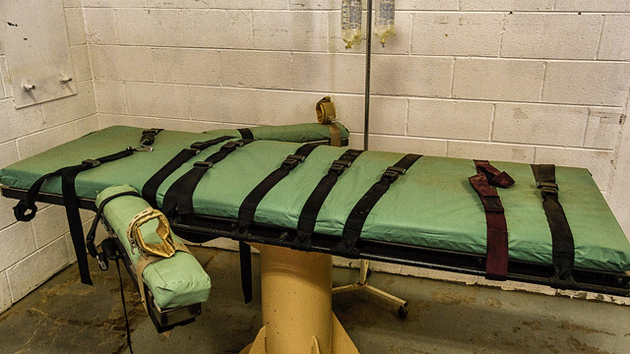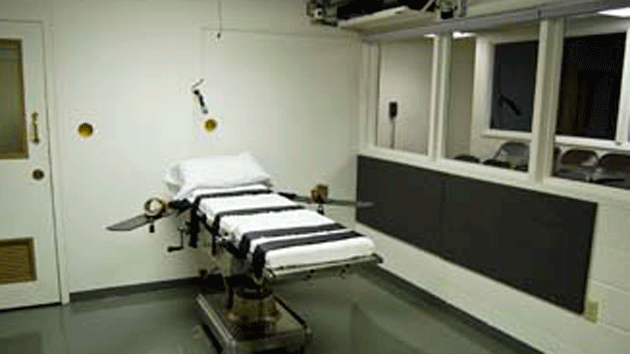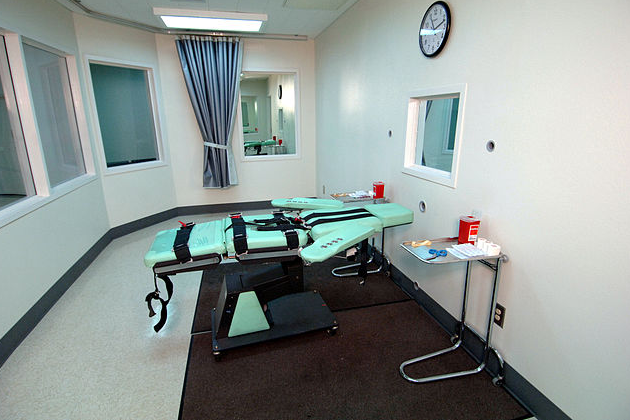
<a href="http://https://www.flickr.com/photos/kenpiorkowski/11501354666/in/photolist-iwks3o-7T8bhE-nvjDfh-nvjDjf-atNfvj-j1SMiz-nuZBTq-544M1z-5492aS-54927Q-fBGXvK-BFeFH-dfe8c-57C3i3-5YEDVk-dCh1ad-otrNGn-nvjDiU-nQS5KZ-nvjDjA-5961SS-cp4c1Q-8VmRzW-4CMpR2-8ViHjY-8ViHdm-8ViHgG-8ViHaq-8ViGQL-8ViGWJ-7wY18P-8ViGsY-8VfCgk-8ViGgs-nQYorz-bwwHQ7-5YJSFo-ediZUT-LtcQL-9Q5HY1-apoiVi-drAGpU-ofdXe-ectFEr-bo99Lg-8VfCdH-nQZbX8-nQY8pG-o8kpJ1-o8sHGH"> Ken Piorkowski</a>/Flickr
When Arizona executed Joseph Wood last week, witnesses said he repeatedly gasped for air during an execution that dragged on for nearly two hours. Wood’s lawyers have demanded, and the state has agreed to, an investigation into whether a new and largely untested combination of lethal drugs caused Wood to suffer unnecessarily.
But it’s possible that Arizona may discover that the real problem with Wood’s execution wasn’t the lethal pharmaceuticals, but the people administering them.
Human error was the culprit in Oklahoma’s botched execution of Clayton Lockett earlier this year. After spending more than an hour trying to find a vein, his executioners accidentally delivered the lethal drugs into his soft tissue rather than into his blood stream, causing him to writhe in pain until the procedure was halted. He died shortly thereafter of a heart attack. In Wood’s case, a preliminary autopsy concluded that the IV lines were set properly, but further results won’t be available for a few weeks.
Amherst College political science professor Austin Sarat, author of Gruesome Spectacles: Botched Executions and America’s Death Penalty, estimates that more than 7 percent of the 1,000 lethal injection executions between 1990 and 2010 have been botched. That’s a higher rate than executions employing the gas chamber or the electric chair, methods courts have deemed unconstitutional as cruel and unusual punishment.
Arizona is a good example of why lethal injections so often go awry. Court records show that the state has a long history of staffing its execution teams with unqualified or marginally-qualified people, often in violation of its own rules requiring the use of experienced medical personnel.
In 2007, a group of Arizona death row inmates sued the state over its execution practices, arguing its procedures were unconstitutional because they were likely to cause inordinate suffering. During the litigation, defense lawyers unearthed background information about the people carrying out executions, as well as creating the lethal injection protocol in the first place.
Perhaps the most troubling disclosure was the role of Dr. Alan Doerhoff, who described himself as “the world’s authority on lethal injection.” Doerhoff is a Missouri surgeon who admitted to having been sued repeatedly for malpractice—more than 20 times by his count. The state medical board reprimanded him in 2003 for failing to disclose some of those suits to hospitals. Two Missouri hospitals revoked his privileges.
Doerhoff had been involved in 54 executions in Missouri, as well as in other states. (He reportedly oversaw the execution of the Oklahoma bomber Timothy McVeigh.) In 2006, he was forced to testify in a constitutional challenge to Missouri’s lethal injection protocol. In his testimony, Doerhoff said his dyslexia was responsible for his jumbled record-keeping and he admitted that it caused him to mix up numbers when working with drug dosages. A federal judge was so horrified by Doerhoff’s description of his work mixing up drugs and improvising on the state lethal injection protocol that he prohibited Doerhoff from ever participating in another Missouri execution.
But that didn’t put Doerhoff out of the execution business. A few months later, Arizona’s corrections chief, Dora Schriro—who had headed Missouri’s corrections department when it first hired Doerhoff—tapped him to oversee executions in Arizona.
In preparation for the 2007 execution of Robert Comer, Schriro rewrote Arizona’s lethal injection procedures, adopting Missouri’s practice of inserting a “central line,” or catheter, into a femoral vein (located in the groin) to deliver the lethal drugs, rather than using smaller IVs in the arms or feet, as most other states do.
The central line was Doerhoff’s preferred execution method. But it requires a high level of medical skill to insert, and medical experts in the Missouri case testified that the procedure is easy to screw up, with potentially disastrous consequences. For instance, if it were mistakenly inserted into an artery, the lethal drugs would cause intense pain. (See page five of this document for an example of why femoral lines are problematic. Beware: It’s not for the faint of heart.)
Doerhoff was hired to help train Arizona’s execution team and participated in Comer’s execution, even though Arizona officials were well aware Missouri had banned him. During one legal challenge to the state’s lethal injection practices, Schriro testified that she didn’t know about Doerhoff’s history until mid-2008. But lawyers turned up an email she received from her staff weeks before Comer’s May 2007 execution describing Doerhoff’s problems in detail. Shriro later acknowledged that Doerhoff probably shouldn’t have been hired. (In 2009, Schriro left the Arizona corrections department to serve as a special advisor to former Arizona governor Janet Napolitano when she was tapped to head the US Department of Homeland Security. Schriro is now the Connecticut state police commissioner.) In an email to Mother Jones, Schriro said, “Imposing the penalty of death is always difficult and during my tenure it was accomplished with the careful planning and gravity that the sentence demands. The 2007 execution complied with the protocol and the imposition of the penalty of death was accomplished quickly and without incident.”
The other members of Arizona’s execution team weren’t exactly well qualified, either. One was a nurse whose license had been suspended for failing to pay child support. He’d once been placed on probation for two years for falsifying paperwork involving the administration of narcotics. He admitted he’d been arrested a half-dozen times, including three times over 10 days in 2007 for driving under the influence. An Iraq war veteran, he blamed the serial DUI arrests on a bad reaction to the medication he was being prescribed for PTSD.
After the 2007 lawsuit, Arizona officials promised to properly vet execution team members. But the state never followed through. “In the protocol, they said they were doing background checks, but in reality they weren’t doing background checks,” says Dale Baich, an attorney for Wood at the Federal Public Defender Service in Arizona, whose office filed the lethal injection challenges.
In 2011, death row inmate Thomas West filed suit in federal court challenging Arizona’s new lethal injection protocol, in which the state had promised to abandon the femoral line process. Lawyers for the condemned examined just how closely the state hewed to its own written rules examining the five executions over the prior 13 months. They discovered that the state virtually never followed its own requirements for training the execution team, hiring qualified medical staff, vetting their backgrounds, or even handling the drugs.
The state’s new rules required that members of the medical team inserting IVs would be “medically licensed individuals with at least one year current and regular practice placing such lines.”
In the five executions examined in the litigation, the medical team rarely met this standard. The team leader didn’t insert catheters, femoral lines, or other IVs in patients as part of his regular medical practice, nor did he meet the state’s own prescribed job qualifications. But he did earn a large amount for the work anyway—a sign of how desperate the state was to find doctors willing to participate in an execution. (National medical associations frown on doctors’ involvement in executions because it violates their ethical obligations to “first do no harm.”) The corrections department paid the doctor $18,000 for a single execution—in cash, so as not to create a paper trail for reporters or lawyers to uncover—and a total of at least $102,000 for all his work for the state.
Another team member was a corrections officer who had served as an EMT in the military in the late 1980s and early 1990s but hadn’t inserted an IV since. He had an arrest record for drunk driving, drinking in public, and writing a bad check.
At least one execution this medical team carried out, lawyers alleged, did not run smoothly. During the 2010 execution of Jeffrey Landrigan, after the state had pledged not to use femoral lines, court records show that the medical team leader tried and repeatedly failed to set a femoral line. The court filings suggest he had no idea how to properly ensure that the inmate was unconscious before administering the drugs that would actually kill him. Baich says that in 10 of the past 14 executions (not counting Wood) in Arizona, executioners used a femoral line that the state had promised to abandon, and that the medical team frequently had trouble inserting the line.
Because of all this history, in June, Wood’s lawyers asked the state to provide details about the people who’d be executing him. “We asked for information about the qualifications for the team. We asked for information about the source of the drugs and we asked for information about how the state came up with this formula,” says Baich. The state refused to provide any of it. “We couldn’t get it. The answer was, ‘We did the background check and [the team members] qualify under the protocol.'” Every court that reviewed the case, including the US Supreme Court, upheld its right to shield that information from Wood and the public.
It’s still unclear what went wrong in Wood’s execution, but as long as states like Arizona are able to keep the public in the dark about who does its killing, botched executions are bound to happen.


















